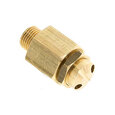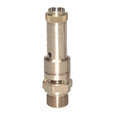Safety Valve Applications
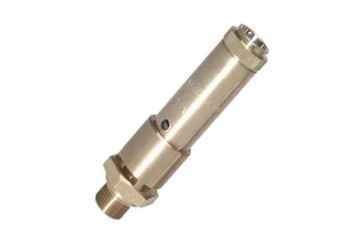
Figure 1: Pressure safety valve
Safety valves are devices that automatically open to relieve excess pressure in a system. They are essential for protecting people and property from the hazards of high pressure. These valves are typically made of durable and corrosion-resistant materials like stainless steel or brass to withstand high pressures and temperatures. Safety valves are used in various applications, including power plants, chemical plants, and oil and gas facilities.
Table of contents
View our online selection of safety valves!
What is a safety valve?
A safety valve has three main parts: the nozzle, disc, and spring. When a system experiences overpressure, the nozzle receives higher pressure from the valve's inlet side and sounds like it's simmering. Once the pressure exceeds the spring's preset pressure, the disc lifts and releases the steam, creating a 'pop' sound. The spring closes the disc after the steam and pressure drop below the valve's set pressure. It's important to check the valve after it has popped to ensure it's not damaged and is functioning properly. Safety valves are typically designed to open completely and quickly when they operate. Safety valves are an essential safety device in many industries.
Boiler
Safety valves are crucial safety devices in a steam system, designed to provide a level of security for plant operators and equipment from overpressure situations. They are situated on the boiler steam drum and will automatically open when the pressure on the valve's inlet side surpasses the preset pressure. The output of a boiler safety valve is typically vented to the atmosphere. However, there are some cases where the output of a safety valve on a steam boiler may be routed to a collection vessel. For example, if the boiler is used to generate steam for a food processing plant, the output of the safety valve may be routed to a vessel where the steam can be condensed and reused.
According to the ASME code, all boilers must have at least one safety valve, depending upon the boiler's maximum flow capacity (MFC). In most cases, two safety valves per boiler are necessary, and a third may be needed if they do not exceed the MFC.
After a safety valve has lifted, it's crucial to perform an inspection to confirm that there are no other boiler servicing issues. Safety valves should only do their job once and should not lift continuously. It's important to fully repair, clean, and recertify safety valves with a National Board valve repair (VR) stamp as local code or jurisdiction requires. Safety valves must be properly maintained as a critical component in a steam system.
Pressure cooker
A pressure cooker traps the steam inside to increase the pressure. However, too much pressure is not safe. A safety valve releases the pressure into the atmosphere when it gets too high.
Typically, a pressure cooker has two built-in valves for pressure release. One is a classic whistle with a pressure-regulating valve, and the other is a pressure-regulator valve located a little away from the first one. The first valve is fixed onto the cooker lid and is made from synthetic rubber, which helps maintain pressure and a good seal. If the pressure exceeds normal levels, the rubber starts to melt, and the disc lifts, creating an outlet for the high-pressure steam to escape. Once the excess pressure is released, the disc returns to its normal position. The safety valve only opens as a last resort if all other steam release methods have failed.
Pressure cooker safety valves should be regularly inspected and tested to ensure they work properly. This can be done by filling the pressure cooker with water and bringing it to pressure. The safety valve should open and allow steam to escape. If the safety valve does not open, replace it.
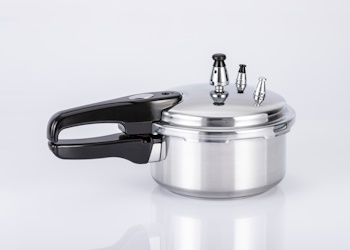
Figure 2: Double valve pressure cooker
Water heater
A water heater could explode without a safety valve due to excessive heat and pressure. There are two main types of water heater safety valves: relief valves and temperature and pressure relief valves (T&P valves).
Relief valves open when the pressure inside the water heater reaches a certain level. It controls system pressure proportionally, protecting pressure-sensitive equipment from damage that overpressure causes. A relief valve begins to operate before the system’s pressure reaches unsafe levels. Read our article on safety valves vs pressure relief valves for more information.
T&P valves open when the pressure or temperature inside the water heater reaches a certain level.
The specific location of the safety valve vent can vary depending on the type and design of the water heater, but there are some common configurations:
Side discharge: Many residential water heaters have the T&P valve on the tank's side. The vent pipe is often directed downward, terminating a few inches above the floor, or it may be piped to a floor drain or outside the building.
Top discharge: Some water heaters have the T&P valve on the tank's top. In this case, the vent pipe may run vertically and terminate above the tank or be piped to a safe discharge location.
Piping to a floor drain: In some installations, the T&P valve discharge pipe is connected to a floor drain, especially when venting the valve to the outside is difficult.
Piping to the outside: The most common practice is to pipe the T&P valve to the outside of the building. This ensures that any released water or steam is safely discharged outdoors, away from people or sensitive areas.
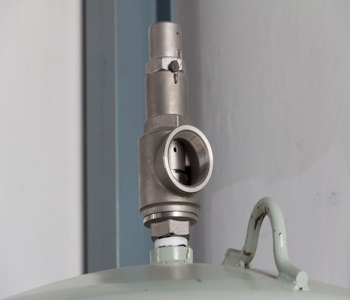
Figure 3: Residential hot water heater pressure relief valve
Compressed air systems
Compressed air systems consist of various components such as air compressors, tanks, piping, and tools. Excessive pressure can cause damage to these components, leading to costly repairs or explosions.
Safety valves help discharge air (typically into the atmosphere) in pneumatic systems if the pressure exceeds the maximum allowable limit, preventing the compressor tank from bursting. Safety valves for compressed air are typically installed in the following locations:
- Air compressor: The safety valve protects the air compressor from damage in the event of a pressure surge.
- Receiver: The receiver is a tank that stores compressed air. The safety valve protects the receiver from damage and prevents it from rupturing.
- Distribution system: The distribution system is the network of pipes that delivers compressed air to the various points of use. The safety valve protects the distribution system from damage and prevents it from rupturing.
FAQs
What is the purpose of a safety valve?
The purpose of a safety valve is to release excess pressure in a system, such as a gas tank or a boiler, to prevent dangerous overpressure situations that could lead to explosions or equipment damage.
What is a safety valve in a cooker?
A safety valve in a cooker is a critical safety feature designed to release excess pressure in the cooking chamber to prevent the cooker from exploding or causing dangerous accidents.
What does a safety valve do in an oven?
A safety valve in an oven automatically releases excess gas when the pressure or temperature exceeds a certain level, preventing potential gas leaks and explosions.




